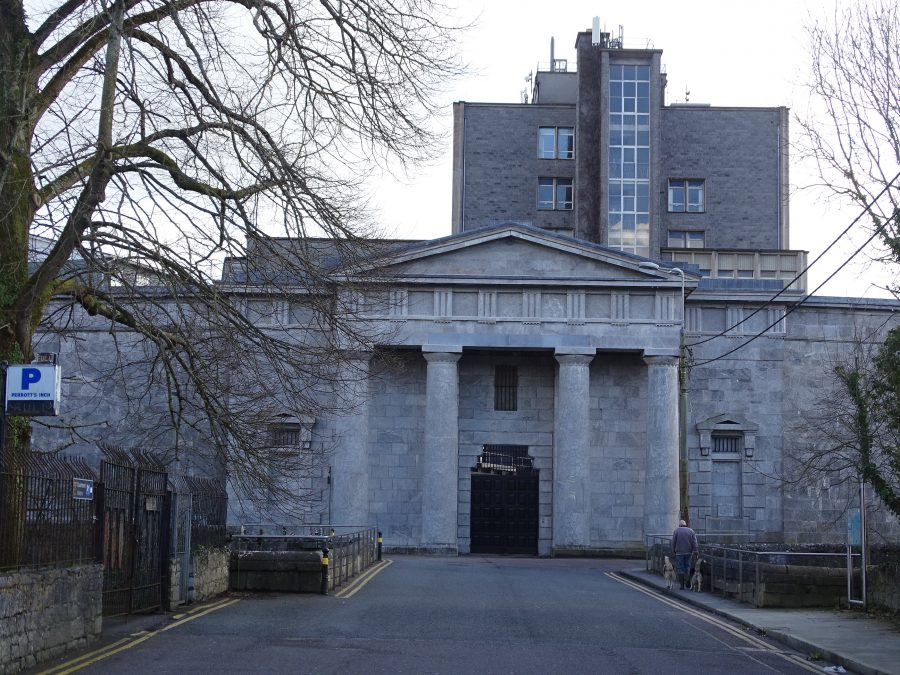
1064a. Remains of Cork Gaol at Gaol Cross, 2020 (picture: Kieran McCarthy).
Kieran’s Our City, Our Town Article,
Cork Independent, 3 September 2020
Remembering 1920: The Hunger Strikers Speak
Maurice Crowe, Adjutant 4th Battalion 3rd Tipperary Brigade, in his Bureau of Military History statement (WS517) was one of those who were on hunger strike at Cork Gaol when Terence MacSwiney stayed for short time before being relayed to Brixton Prison.Having begun on 11 August 1920, the hunger strikes began as a demand for unconditionalrelease. Maurice recalls that in Cork Gaol Cork Brigade member Tadhg Manley of Midleton was incharge of the sentenced prisoners, and member Mick Fitzgerald in complete charge of all the prisoners.
One night, when the hunger strike had been on for about fourteen days, Maurice, Con Neenan of Cork and Tom Crawford of Ballylanders were transferred on stretchers to a hospital in Cork’s Victoria Barracks, where they were to be forcibly fed. However, as the press next day came out very strongly about this, the forcible feeding did not take place. Two nights later, during curfew, they were thrown into a military lorry. Orders were clearly given by the officer in charge – should the prisoners attempt to escape, or should there be any attempt at rescue, they would be shot. They were then taken to a boat called the Heather. Other prisoners on hunger-strike arrived from Cork Prison about thirty in all. The prisoners were given mattresses but with no covering and were put into a corner of the boat.
Arriving at Pembroke at 6pm the following evening eighteen hours after they had started there was a special train waiting for them. Some struggled onto the train from the ship, helping others, but some were too weak and were taken on stretchers to the train. They left Pembroke by train at about seven o’clock that evening, with a strong military escort. The train was shoved into a siding at Reading for about three hours. They arrived at Winchester prison about ten o’clock the next morning. After a week there, the prison staff there made an attempt at forcible feeding. The prisoners from Cork Gaol were still on hunger-strike, but an order was received to go off hunger-strike. They were brought back to Cork a month later.
In Cork Maurice was tried by general court-martial and sentenced to three years’ penal servitude. Later, he was transferred to London’s Wormwood Scrubbs Prison and thence to Parkhurst Convict Prison in the Isle of Wight. In Parkhurst, there were in all forty Irish Republican prisoners, some of whom were sentenced for operating in England. He was appointed IRA Officer-in-Command of the prisoners. Fr Dominic, chaplain to the Lord Mayor of Cork, who had been sentenced to three years and who had just arrived, was appointed Vice Officer-in-Command. They were all put into prison garb and transferred into different working parties.
One morning while out at exercise, all the Irish prisoners, at a given signal, walked together out of the exercise ring, shouted, etc, causing an uproar, arid refused to associate with criminals. They were dragged by the warders into the cells where they tore off the prison garb. They were then put into what is known as the canvas dress and handcuffed to a strap of leather around the waist. Maurice notes in his account;
“We refused to submit to the prison crop but were knocked down and the hair forcibly clipped or torn off. We refused to exercise unless left together, but we were dragged out refusing to walk and dragged in again. They soon got tired of this and, after a week or so, we were all put into one wing, apart from the convicts. We exercised together and brought our own food from the cookhouse. The food baskets and boxes were numbered for the different wings, and our basket had the letters, ‘S.F.’, painted on it, meaning Sinn Féin prisoners”.
Back in Cork Gaol, Michael O’Donoghue, Engineer Officer, 2nd Battalion, Cork No.1 in his Bureau of Military History statement (WS1741) recalls that during September to October 1920, nightly, thousands assembled after 6 pm at the Gaol Cross. Outside the prison they prayed and sang to strengthen the spirits of the men refusing food within. The most generally sung piece was a religious hymn – Father Faber’s typically English composition, Faith of our Fathers. Michael notes of the song: “My own view is that it was chosen to banish any conscientious scruples or theological misgivings, which the hunger strikers within may have had about the moral rectitude of their deliberate abstention from food even to the death”.
For quite a while those outside were able to communicate directly with the hunger strikers each night. Among the crowds were many Cork Brigade No.1 men including signallers. Messages were sent in semaphore from the windows of the prison hospital where the hunger strikers were, and which faced Gaol Cross. Before dusk, white cloth handkerchiefs or pillow covers were used by the signalling prisoner at the window. After dusk, a light was employed to flash brief messages to the waiting crowds below. IRA signallers received the messages and replied in Morse. In this way each night the progress of the struggle inside was relayed in an up-to-the-minute story to the anxious citizens of Cork. The invariable question from the men within was “How is Terry Mac?”. The lads always signalled back the latest news that they had from Brixton. It was an extraordinary moving scene before the grim gates of Cork Prison each night until curfew, usually to 8pm, and earlier at weekends.
Kieran’s new book Witness to Murder, The Inquest of Tomás MacCurtain is now available to purchase online (co-authored with John O’Mahony 2020, Irish Examiner/www.examiner.ie).
Captions:
1064a. Remains of Cork Gaol at Gaol Cross, 2020 (picture: Kieran McCarthy).
1064b. Remains of Cork Gaol at Gaol Cross, 2020 (picture: Kieran McCarthy).

1064b. Remains of Cork Gaol at Gaol Cross, 2020 (picture: Kieran McCarthy).